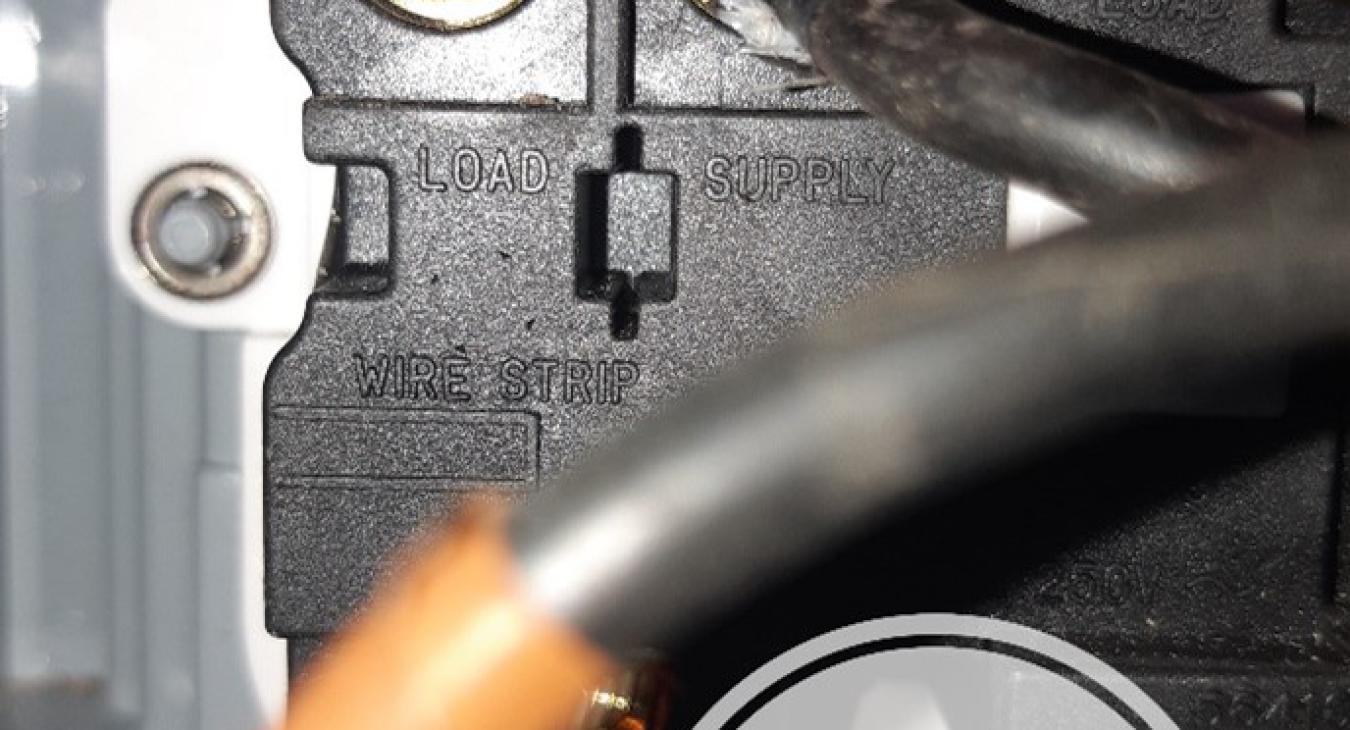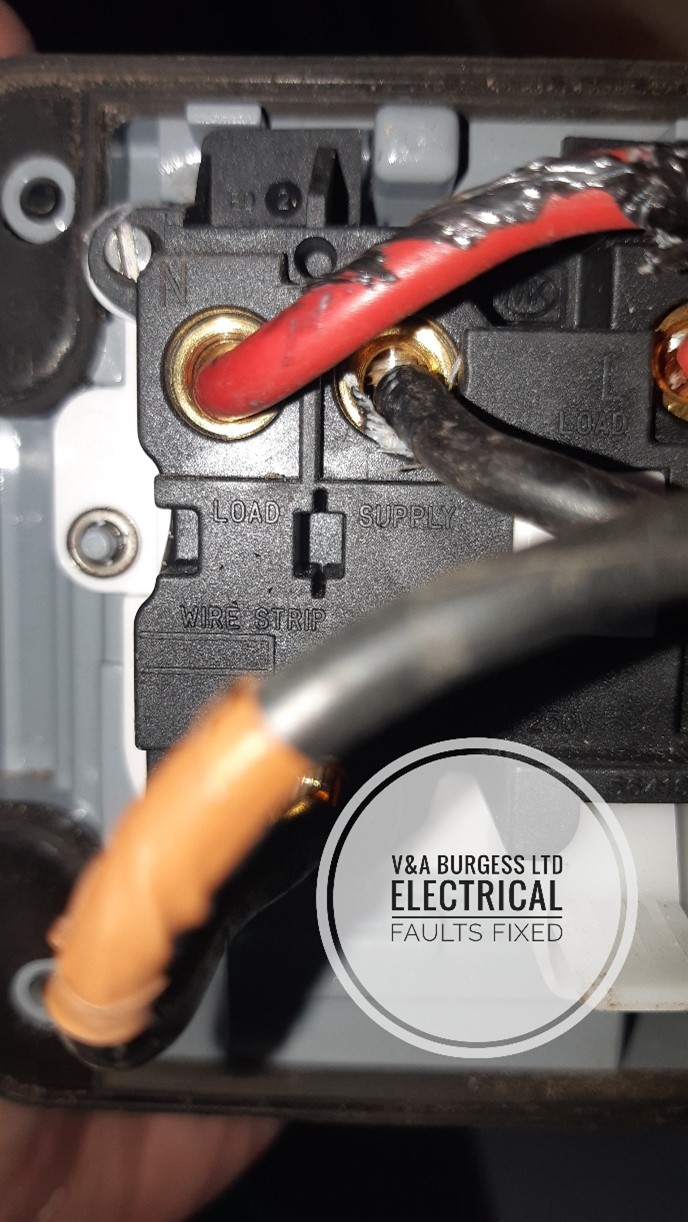
Table of Contents
- Regular Problems
- Lack of knowledge and expertise
- Fire Hazard
- Electrocution Hazard
- Regulations Breaches
- Incorrect Materials Selection
- Overloading Circuits
- Incorrect Tools
- Lack of Safety Measures
- Inability to Test the Work Correctly
- Potentially voided insurance cover
- Unforeseen Consequences
- Common Questions
The photograph shows part of a wiring installation that had been carried out in a garden. There were several issues that we uncovered including this issue here.

If you look closely, you can see that the red cable is connected into the ‘N’ terminal and the N cable is actually connected into the ‘L ’ terminal.
The cables entering the box underneath had not been correctly terminated and were allowing moisture into the wiring enclosure.
Moisture and electrics don’t mix, DIY and electrics also don’t mix.
1) Regular Problems
We regularly attend residential projects where switches and sockets have been wired up incorrectly, electrical repairs have been undertaken and without any testing carried out to the circuit first to ascertain its safety and suitability for any additional sockets or switches. These issues fail to meet the safety standards!
DIY electrics are potentially dangerous. A great understanding of BS7671 (IET wiring regulations) is needed along with some fairly substantial and expensive test equipment along with the knowledge and experience to use the equipment and interpret its results.
We are a nation of DIY lovers and it is always tempting to attempt electrical projects, alterations, repairs, or replacements ourselves but in reality, there are many hidden dangers that will go simply unnoticed by the general public when carrying out works such as this. When it comes to Electrical works in your home, please consider using a professional electrician with the necessary skills to help you get the finish you want by installing those decorative sockets, switches or maybe that new light fitting.
There are many jobs that are not inherently dangerous if you really wish to carry out your own electrical work and basic DIY can be enjoyed by everyone but it’s best to stick to wallpaper, paint, and flooring than dangerous jobs such as Electrical Installation and repairs.
There are a number of reasons why DIY work may be dangerous and should not be performed by anyone other than an electrician:
- Lack of Knowledge and Expertise
- Fire Hazard
- Electrocution Hazard
- Regulations Breaches
- Incorrect Materials Selection
- Overloading Circuits
- Incorrect Tools
- Lack of safety Measures
- Inability to Test the Work Correctly
- Potential Voided Insurance Cover
- Unforeseen Consequences
2) Lack of knowledge and expertise
The DIY approach to electrical work will more often than not, involve individuals that have not had the proper training to understand the safety requirements of the wiring regulations, the building regulations and the considerations that are necessary before extending or altering electrical circuits or electrical installations.
This lack of knowledge and expertise will usually result in (often dangerous) mistakes with wiring, circuit design and safety measures. This will often lead to further problems down the line with the wiring installation and will likely result in the need for remedial works by a professional or the replacement of the initial work.
Back to top3) Fire Hazard
Incorrectly wired circuits, the lack of consideration for maximum load, design current and other electrical design considerations will regularly lead to wiring problems, overheating and fire risk. When wiring is incorrect, it can catch fire before any safety measures are likely to act to prevent these dangers.
Connections that are too loose or too tight can lead to fire risk. Manufacturers often have a recommended torque for their connections and should this not be adhered to, there can be grave consequences.
Back to top4) Electrocution Hazard
Incorrectly wired circuits, electrical accessories, lights and plug sockets can lead to a real risk to life. Where these items are wired incorrectly, many electrical system consumer units will not detect this and will leave the occupants of the property and the users of the system open to electric shock.
Incorrectly isolating the power supply to the circuits and failure to carry out safe isolation with the correct equipment can lead to electric shock, burns or electrocution.
Back to top5) Regulations Breaches
Whilst there are some jobs that are seen as DIY for instance swapping a light fitting over, there are still requirements or BS7671 that MUST be followed. Swapping one type of light fitting for another can necessitate the requirement for an Earth connection.
Without adequate confirmation and testing there can be no guarantee that the earth connection is in place, suitable and of a sufficiently low resistance to ensure that automatic disconnection of supply will occur in the event of a fault!
This is one of MANY regulations that must be followed in the current (560-page 18th edition) wiring regulations.
Back to top6) Incorrect Materials Selection
When carrying out DIY work, the average DIY person is likely to select the cheapest materials or the most expensive rather than finding the suitable materials for the job. There are many instances where the price is irrelevant but rather the type, brand and suitability of the materials is the most important thing.
Cheaper materials are likely to fail more quickly and be of lower quality. They are also often more difficult to install which is likely to compound the issue of early failure. Your average DIY person is not generally able to ensure that the materials selected are compliant with the relevant British Standard or the wiring regulations.
Back to top7) Overloading Circuits
Where circuits are extended and altered by an electrician, there are considerations that take place before the work is carried out. These are such things as compliance with regulation 134.1.1,132.16 and others.
An electrician considers if the existing installation is suitable to extend by checking the standard of the earthing, the electric shock prevention measures in place, the quality of the existing cabling (through specific tests), the earth continuity of the circuit to be altered and so on.
Not every circuit can be extended and, in some cases, it is not safe or suitable to do so. DIY ELECTRICS unfortunately will not cover any of this but rather seek to simply continue adding on to an aging or dangerous system without adequate checks, testing and compliance with the safety wiring regulations.
Back to top8) Incorrect Tools
Without the use of the correct tools, there is a risk of electric shock, injury, damage to new installation work and existing installation work.
The average electrician has a never-ending tool kit that costs a fortune. Purchasing the correct tools to carry out the work is likely to exceed the costs of getting the job done right in the first place. The test equipment alone to ensure that circuits are tested in compliance with the regulations is likely to be over £1000.
Back to top9) Lack of Safety Measures
Where DIY work is carried out, there will generally be no consideration for safety measures. Safety measures include:
- Adequate trip times achieved and recorded
- The correct certification filled in
- Correct installation technique
- Check of circuit resistance before circuits are extended
- Correct selection of protective devices to achieve required compliance
There is also likely to be a lack of PPE where a DIY person undertakes a job as the risks are often unknown to them or not understood entirely. Professionals will undertake all the necessary safety measures and ensure that the correct protective equipment and devices are installed.
Back to top10) Inability to Test the Work Correctly
There is a requirement under the wiring regulations that all electrical work is subject to initial verification if new work or prior testing if adding on to existing electrical circuits. There are many sections of the wiring regulations that need to be complied with and understood before work can begin and without the understanding, the test equipment and knowledge of its use, it would be dangerous to carry out DIY ELECTRICS and impossible to comply with the regulations.
Back to top11) Potentially voided insurance cover
We all know that insurance companies will look into claims as thoroughly as possible when one arises. Should they find that electrical work has been carried out without the required certification and to a standard below the minimum safe standard set out in the wiring regulations then it is likely that an insurance claim for property damages may be rejected on the ground of unsafe or non-compliant works.
Back to top12) Unforeseen Consequences
Non-compliant electrical work can lead to an increased risk of electric shock, fire, and premature failure of a wiring system. None of these are outcomes are intended when carrying out DIY work but nevertheless the risk exists.
Back to top13) Common Questions
13.1) What electrical work can I safely carry out myself?
- Changing a light bulb
- Checking power leads for damage
- Checking electrical items for damage
- Replacing plastic light switches like-for-like
- Checking the RCD by pressing the test reset button
- Replacing a plastic pendant style light fitting for another the same
- Resetting the device when the circuit breakers trip
Whilst the above jobs are generally not going to cause many problems you could still run into problems whilst replacing a light fitting or light switch!
13.2) Can I put 2 double sockets on a spur?
Yes and No. Let’s look at the question in more detail.
If there is a Fused Spur or Fused Connection Unit in place THEN it is ok to add 2 double sockets providing the intended use of the sockets is unlikely to overload the fused spur unit.
If, however, there is not a fuse connection unit in place then things could be quite different. In UK homes, many plug socket circuits are wired as a Ring Final Configuration (sometimes referred to as a Ring Main). When this is the case, it is not allowable to spur off the ring to 2 double sockets WITHOUT fusing the cable down at that point. The load balancing of the Ring Final Circuit should also be taken into consideration. There is more detail in Appendix 15 of the wiring regulations BS7671 regarding safe modification of Ring Final Circuits.
If the circuit is a radial circuit, then it is generally a little easier to modify.
We never recommend carrying electrical work out yourself as there are simply too many dangers present and its SO EASY to get it wrong.
13.3) Can you spur off a spur?
Yes and No. This is effectively adding 2 sockets to a circuit. If the circuit is a Ring Final Circuit, then there are many issues to consider as per Appendix 15 and if the circuit is a radial circuit, then things are a little easier.
Regardless, there is electrical testing and certification work that MUST be carried out before, during and after the works have been completed which are unlikely to be done if the work is carried out on a DIY basis.
The sensible thing to do which will ACTUALLY SAVE YOU MONEY is to get an electrician in to carry out the work.
13.4) Can I change a spur to a socket?
It is possible to change a spur to a socket providing the circuit is correctly protected at source by the correct protective device and the wiring regulations are followed.
Bear in mind that the spur may be fed from a low powered circuit meaning that there may not be adequate electrical amperage available for your needs.
Your homes electrical system should only be worked on by a qualified electrician as many electrical tasks require testing and certification to ensure that each legal requirement has been met and the serious risk of electrical shocks has been minimised. Electrical issues and electrical fires can cost money and lives. Carrying out your own work is not worth the risk for the reward.
If you have any further questions, please get in touch.
Back to top











